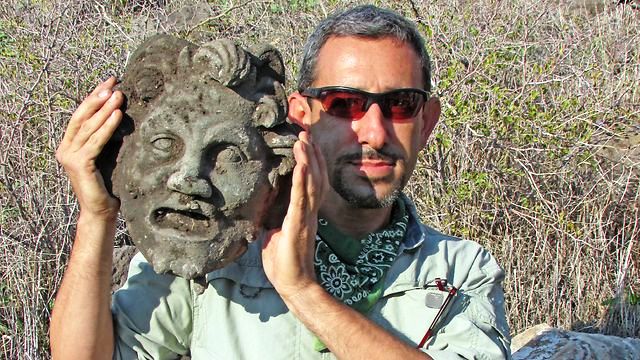Archaeologists discovered a one-of-a-kind pagan mask at a recent excavation in northern Israel, conducted by the University of Haifa.
A large bronze mask of the pagan god Pan, the only one of its kind every discovered, was recently uncovered at the University of Haifa’s excavation at Hippos-Sussita National Park on the eastern shores of the Sea of Galilee in northern Israel.
Dr. Michael Eisenberg of the University’s Zinman Institute of Archeology, who headed the dig, explained that bronze masks of this size are extremely rare. Most of the known bronze masks from the period are miniature and usually do not depict Pan or any of the other Greek or Roman mythological images, he said.
In recent years, several mysteries of Hippos-Sussita have been revealed; first, a sculpture of Hercules was exposed following the winter rains of 2011, and two years later, a basalt tombstone with a sculpture of the deceased’s bust was uncovered. Now there is a new and exciting surprise: the uncovering of a large, bronze mask in the form of the god Pan/Faunus.
Excavations at Hippos-Sussita are usually conducted in the summer. However, a series of intriguing structures on the ridge of the city, where the ancient road had passed, led to a one-day dig in the winter. It focused on a basalt structure that researchers had assumed was a type of armored hangar for the city’s projectile machines. The finding of a ballista ball made of limestone, a different material from the basalt that was customarily used at Hippos-Sussita, made them realize that it was an enemy’s projectile.
In light of this interesting find the researchers decided to search the structure for coins to help in dating the ballista balls. Dr. Alexander Lermolin, head of the conservation laboratory at the university’s Institute of Archaeology, used a metal detector that indicated the location of a new finding: the large bronze mask.
Horns like those on the mask are usually associated with Pan, the half-man, half-goat god of the shepherds, music and pleasure. A more thorough cleaning in the lab revealed strands of a goat beard; long, pointed ears, and other characteristics that led Dr. Eisenberg to identify the mask as depicting a Pan/Faunus/Satyr.
The mask was found near the remains of a basalt structure with thick walls and very solid masonry work, which suggest a large structure from the Roman period. A Pan altar on the main road to the city, beyond its limits, is quite likely, as Pan was worshiped not only in the city temples, but also in caves and in nature. The ancient city of Paneas, north of Hippos-Sussita, included one of the most famous worshiping compounds to the Pan god inside a cave. Because they involved drinking, sacrificing and ecstatic worship that sometimes included indecent activities, rituals for rustic gods were often held outside the city.
The archaeologists have begun to uncover the basalt structure in the hopes of finding more clues to its purpose.
By: United with Israel Staff

Free Ebook: 10 Best Places to Visit in Israel
The Land of Israel has provided the backdrop for some of the most important events in human history. From the Old City in Jerusalem to the Sea of Galilee, people from all over the globe visit the Holy Land each year to take in the breathtaking scenery and inspiration of Israel. Now you can experience this beauty for yourself from the comforts of home and maybe plan a trip of your own to Israel. Get the free, exclusive eBook from United with Israel: The 10 Best Places to Visit in Israel.
CLICK HERE TO DOWNLOAD: 10 Best Places in Israel.
Do You Love Israel? Make a Donation - Show Your Support!
Donate to vital charities that help protect Israeli citizens and inspire millions around the world to support Israel too!
Now more than ever, Israel needs your help to fight and win the war -- including on the battlefield of public opinion.
Antisemitism, anti-Israel bias and boycotts are out of control. Israel's enemies are inciting terror and violence against innocent Israelis and Jews around the world. Help us fight back!
